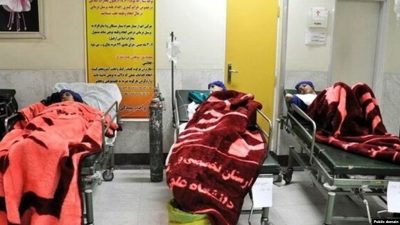A raiva e o medo aumentam no Irã enquanto os dedos são apontados para grupos ultraconservadores e de oposição sobre incidentes de envenenamento

Centenas de alunas no Irã foram hospitalizadas nas últimas semanas depois de serem envenenadas pelo que as autoridades descreveram como um ataque de gás “intencional”.Although incidents have been reported across the country, the majority of cases have centred around the holy city of Qom.
BBC Persian reported that as many as 800 students in Qom had been poisoned so far, and that a number of cases had also been detected in the capital, Tehran. Younes Panahi, a deputy health minister, told media that the poisonings were likely intentional – though he later claimed he was misquoted – while Mohammad Jafar Montazeri, the attorney general, has also described them as “probably intentional”.
A doctor who treated some poisoned students told Middle East Eye the victims had “smelled something like the smell of sewage and salt, and had symptoms of dizziness, nausea and difficult breathing”.
He added that a number of those he treated said they had “seen a suspicious thing thrown inside the school”.
Yet so far, no one has been able to pinpoint who might be responsible, with some suggesting an attempt by ultra-conservatives to disrupt the education of girls and others pointing to anti-government opposition groups.
MEE spoke to a teacher in one of the schools affected by the poisoning. The teacher, who asked to remain anonymous, said two of her colleagues had also been hospitalised.
“The smell of the poison is like a rotten smell, but it is not gas – it is close to gas smell and at the same time it is something like a thick and pungent smell,” she explained.
“The students faced severe coughs and difficulty in breathing and some were hospitalised.”
Iran’s health ministry has been keen to stress that the effects of the poison have been mild, primarily causing “muscle weakness, lethargy, and nausea for a few hours”.
However, the repeated incidents have left parents deeply worried about sending their children to school, with the lack of information about the nature of the poison – and the culprits – further heightening fears.
“Of 550 people, only four students come to the school. The students are also terrified,” said the teacher.
“The poison effects are to the extent that some of the students aren’t able to walk for a few days.”
‘Extremist’ attacks?
A number of theories have spread about the possible motives for the poisoning of schoolgirls. A popular one is that religious fundamentalist groups may be attempting to prevent the education of women and girls.
One conservative cleric based in Qom, speaking on condition of anonymity, said he believed it could be the work of “extremists” inspired by the Taliban in neighbouring Afghanistan.
“The number of such extremists is not too much and they can mostly be found in Mashhad, Shiraz, Qom and Isfahan, but they are really a little minority,” he said.
He said these groups viewed the education of girls as spreading “corruption” and undermining both family and Islamic values.
“Such persons’ perception of the religion is reactionary, ridiculous and unwise,” he added.
Other religious and political figures concurred with this theory.
Mohammad Ali Abtahi, a cleric who was a senior figure in the reformist government of Mohammad Khatami, compared the possible culprits to the Africa-based militant group Boko Haram.
“Extremism, especially the religious ones, are the biggest danger to all societies,” warned Abtahi, while calling on the security apparatus to identify and arrest the extremists.
Meanwhile, Masoumeh Ebtekar, former vice president for women and family affairs, tweeted that the police and judiciary needed to act “immediately” and compared the incidents to a series of acid attacks in the city of Isfahan in 2014, which allegedly targeted women not wearing “appropriate” hijab.
یکیک یک یک یک
gas نکندمثل اسیدپاشان اصفهان شود! آیا نسبتی بین عدم تصویب قوانین نفی خشونت علیه زنان و این وقایع وجود دارد؟ یک بار برای همیشه حجت را بر متحجران ضد زن تمام کنید.— معصومه ابتكار (@ebtekarm_ir) 27 de fevereiro de 2023
chamadas de contraterrorismo
Várias pessoas pediram ao governo que trate o envenenamento como relacionado ao terrorismo e inicie investigações de contraterrorismo.
De acordo com a Fars News Agency, apoiada pelo estado, os serviços de segurança prenderam três suspeitos na terça-feira em conexão com o envenenamento.
A Fars disse que havia relatos “não confirmados” ligando os envenenamentos ao Mojahedin-e-Khalq (MEK), um grupo de oposição iraniano dedicado à derrubada da República Islâmica.
Embora o MEK – que inicialmente apoiou a Revolução Islâmica de 1979, antes de se separar da administração pós-xá – tenha realizado numerosos ataques a bomba mortais no país na década de 1980, nas últimas décadas eles se concentraram principalmente em fazer lobby junto a governos estrangeiros e fazer campanha internacional contra a República Islâmica.
Na quarta-feira, a agência de notícias estatal Tasnim disse que houve outro ataque com gás na cidade de Ardabil, no norte, que forçou a hospitalização de 108 estudantes. A agência de notícias também relatou mais envenenamentos em três escolas em Teerã.
A ambiguidade em torno dos ataques e a falta de informações do governo alimentaram a raiva em todo o país.
Os pais protestaram do lado de fora do prédio da província de Qom, pedindo que mais seja feito para proteger seus filhos.
Os envenenamentos também ocorreram após meses de manifestações em massa que se concentraram no tratamento das mulheres no país, desencadeadas pela morte da mulher curda Mahsa Amini sob custódia após sua prisão por “hijab inadequado”.
*
A imagem em destaque é de domínio público

Nenhum comentário:
Postar um comentário